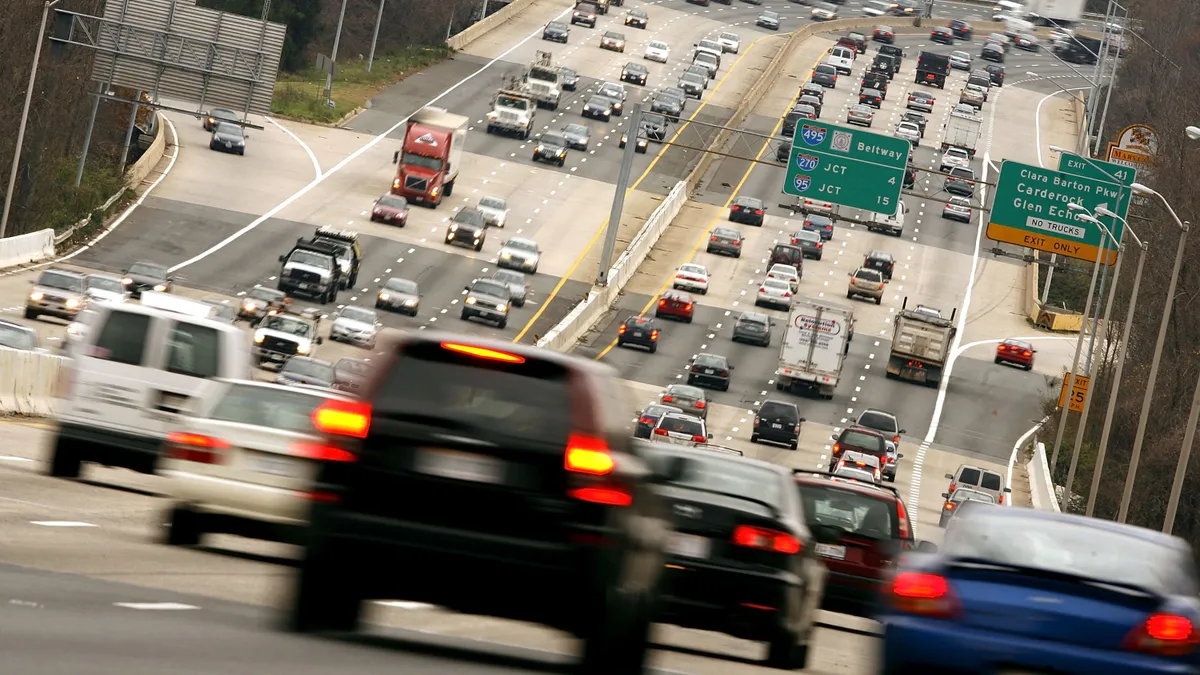Dive Brief:
-
The New York City-Newark-Connecticut metropolitan region was the most congested urban area in the country in 2020, surpassing the Los Angeles-Long Beach-Anaheim region, which took top honors in 2019, a new report found.
-
Congestion decreased in cities throughout the U.S. during the pandemic, with travel delays on par with what motorists experienced in 1997. However, traffic began to build back up toward the end of 2020, and experts say delays will eventually return to 2019 levels.
-
The rankings come from the Texas A&M Transportation Institute’s annual Urban Mobility Report, which analyzes traffic conditions in 494 U.S. urban areas. The report calculates delay by factoring traffic count information from the Federal National Highway Administration’s National Highway Performance Monitoring System and speed data collected by INRIX.
Dive Insight:
As workplaces shut down and laid off employees or had them telework during the COVID-19 pandemic, traffic delays dropped to levels not seen since 1997. In 2019, commuters in only five urban areas in the country had less than 30 hours of extra annual driving time. Last year, commuters in 73 urban areas spent that little extra time in traffic, a benchmark that had not been reached since 1992.
The New York City-Newark, New Jersey-Connecticut metro region, which the report named the most congested urban area in the country last year, saw its total annual commuter delay hours fall 42% between 2019 and 2020, to 494,268 for the year. This surpassed the 365,543 delay hours accumulated in the Los Angeles-Long Beach-Anaheim, California, region. The densely populated region in Southern California was the most congested in 2019 but saw its delay hours fall 62% in 2020.
This may be due to a large number of people who typically use New York City’s transportation system, opting to walk, bike, or drive into work during the pandemic instead, David Schrank, a senior research scientist at the Texas A&M Transportation Institute and co-author of the report, said. An increase in truck traffic making deliveries to the millions of people who live in the area may have also factored into the delays, he speculated.
The Los Angeles metro region, on the other hand, has a massive freeway system that can handle the decreased amount of traffic during the pandemic, Schrank added.
The Tampa-St. Petersburg, Florida, region’s total annual commuter delay hours fell 65%, the largest drop in traffic congestion in the U.S. in 2020. The significant drop in rush-hour traffic can be attributed to the switch to telework during the pandemic, according to David Green, executive director of the Tampa Bay Area Regional Transit Authority (TBARTA).
But that does not mean the congestion is gone for good. According to the report, toward the end of 2020, traffic started building back up in many areas to levels experienced in the mid-2000s.
The population is going to continue to grow, as will the need for more transportation options, both for residents and goods and services. Congestion experienced in 2019 could return in certain cities soon, or several years down the road, depending on a number of factors, said Schrank.
Factors that could affect delays include a city’s layout, transportation options, whether workers start heading back into the office, and whether its population consists of more retirees who use the roads for day-to-day activities or working commuters during rush hour, he said. The freight and trucking industry didn’t really drop off during the pandemic, as trucks delivered more goods and services to people’s homes, the report found. That could also factor into slower traffic in cities, Schrank said.
“That pressure alone will probably push us back to where we were," said Schrank. “It’s just a matter if it’s a year, three years or five years."
Green said he expects Tampa Bay’s congestion issues to get far worse over time, exceeding 2019 levels, since it is one of the fastest growing communities in the U.S., a trajectory he projects will continue over the next 25 years. Since the city has a low housing inventory, the growth has significantly raised housing costs, pushing lower-wage workers into more affordable areas, where they need cars to get to work.
Compounding the city’s traffic problems are its regional transit options, with Tampa having one of the worst public transportation systems in the country, he said.
To help alleviate some of the congestion, TBARTA is working on a bus rapid transit project that would connect three counties in the region — Pasco, Hillsborough and Pinellas — to several popular areas such as downtown Tampa, downtown St. Petersburg, the University of South Florida, and Wesley Chapel.
"The goal is all-day modern mobility that provides quick, safe, reliable, frequent and regional rapid service," said Green.
The authors of the report suggested advances in technology for traffic systems and vehicle safety, such as cars talking to each other, could help remediate traffic. Diversity in developments that mix shops, jobs and homes would also help as would giving people more options surrounding their travel routes and the choice to work from home.
Cities should implement an array of traffic remediation solutions that are right for their specific communities, said Schrank. Sometimes the solution could involve more street or highway lanes, more public transportation options, or better bicycle or pedestrian routes.
To ease congestion, city leaders need to build out their bicycle and pedestrian infrastructure to allow people to make shorter trips without cars, said Zabe Bent, director of design at the National Association of City Transportation Officials. They also need to look at the areas people are traveling to beyond the downtown areas and the times they are making those trips. Then cities should invest in transit options that make those trips comfortable, safe and convenient, Bent said.
"We know this is the way forward for recovery, but we also know it’s the right solution for our climate needs, which we are obviously in crisis with, and for social justice and public health," Bent said.












